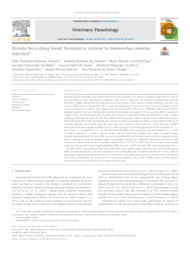Morada Nova sheep breed: resistant or resilient to Haemonchus contortus infection?
Morada Nova sheep breed: resistant or resilient to Haemonchus contortus infection?
Author(s): TOSCANO, J. H. B.; SANTOS, B. dos; HAEHLING, M. B. VON; GIRALDELO, L. A.; LOPES, L. G.; SILVA, M. H. da; FIGUEIREDO, A.; ESTEVES, S. N.; CHAGAS, A. C. de S.
Summary: Morada Nova is a Brazilian hair sheep breed that is well adapted to the country?s mainly tropical climate and has good potential for meat and leather production. This breed is reported to be resistant to Haemonchus contortus infection, a highly desired characteristic due to the large impact of this parasite on sheep farming. Therefore, the present study aimed to characterize 287 recently weaned Morada Nova lambs and 123 ewes in relation to their resistance against H. contortus. The animals were dewormed and 15 days later artificially infected with 4000 H. contortus L3 (D0). They were individually monitored by periodic assessment of fecal egg count (FEC), packed cell volume (PCV), and live weight (LW). On D42, the sheep were again dewormed and submitted to a new parasitic challenge, following the same scheme. The animals of each category (lambs and ewes) were ranked according to individual mean FEC values, and classified as resistant (R, 20%), intermediate (I, 60%), or susceptible (S, 20%) to H. contortus infection. At weaning, high FEC were observed in all three phenotypes (P > 0.05). After the artificial infections, there was a significant difference (P < 0.05) among the three lamb phenotypes for the mean FEC (R < I < S), PCV (R > I > S), and LW (R = I > S). The infection levels (FEC) were negatively correlated with PCV (r = -0.66; P < 0.001), and LW (r = -0.30; P < 0.001). Despite this, the lambs were resilient, since more than 88% of these animals maintained the PCV above 24%, even when heavily infected. The importance of selective parasite control before weaning to reduce the negative impact on slaughter weight was evidenced, taking into account the high positive correlation between LW at weaning and final LW (r = 0.73; P < 0.001). The ewes, in turn, were strongly resistant to the parasite. Despite highly significant differences (P < 0.001) for mean FEC between phenotypes (R < I < S), 98% of the ewes maintained FEC below 4000 EPG. Their health was not affected, since PCV and LW did not differ between phenotypes, and these parameters were not significantly correlated with FEC (P > 0.05). With the phenotypic characterization performed here, it is possible to introduce procedures for parasite control in Morada Nova flocks, facilitating the target-selective treatment approach. The results of this study can also support improvement of meat production by the Morada Nova breed.
Publication year: 2019
Types of publication: Journal article
Observation
Some of Embrapa's publications are published as ePub files. To read them, use or download one of the following free software options to your computer or mobile device. Android: Google Play Books; IOS: iBooks; Windows and Linux: Calibre.
Access other publications
Access the Agricultural Research Database (BDPA) to consult Embrapa's full library collection and records.
Visit Embrapa Bookstore to purchase books and other publications sold by Embrapa.

